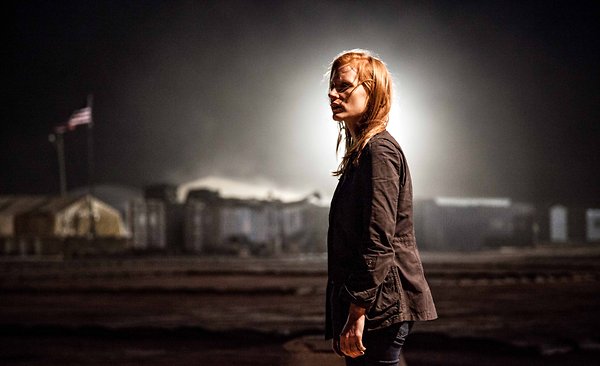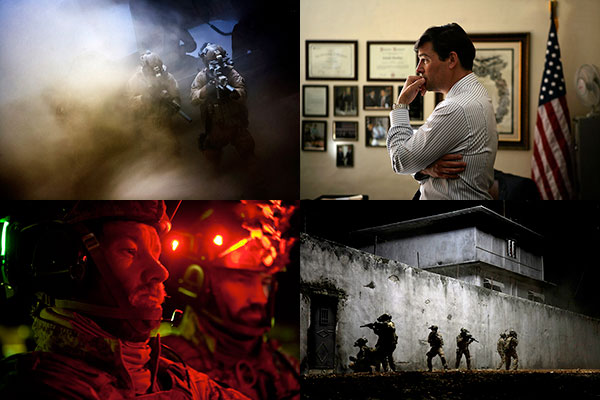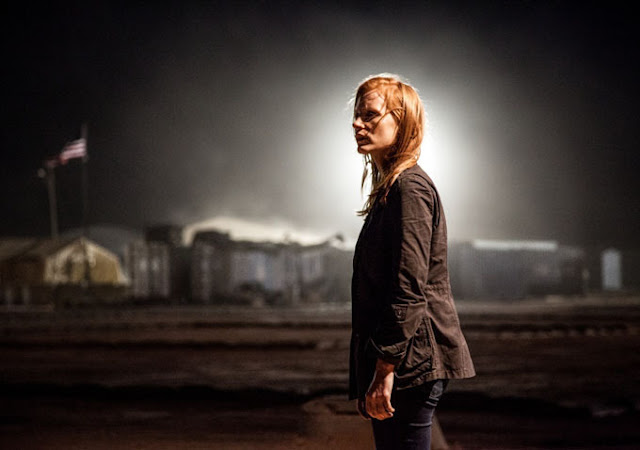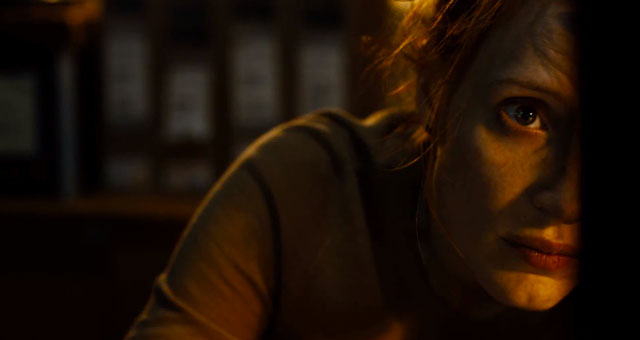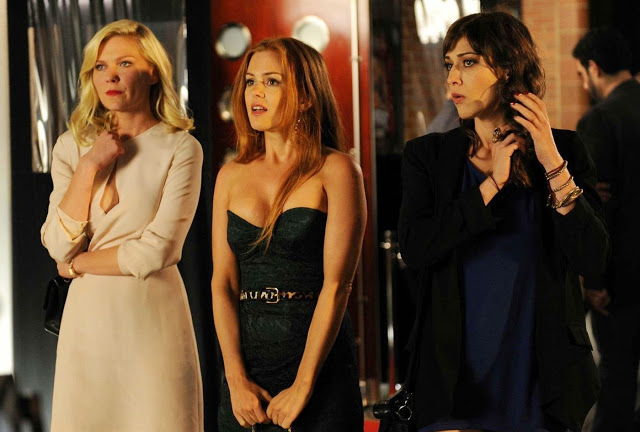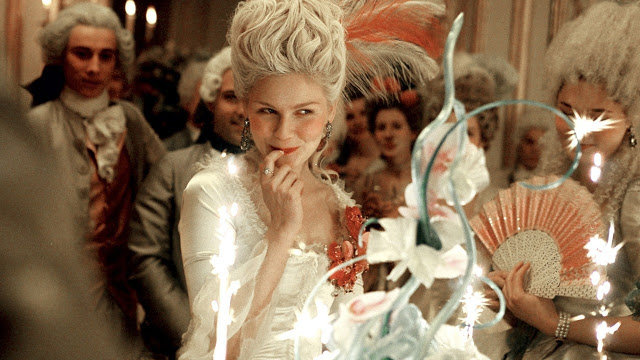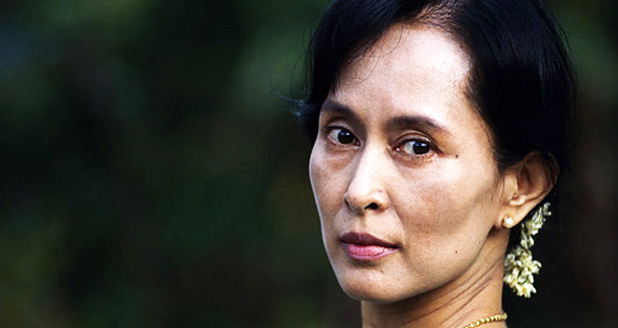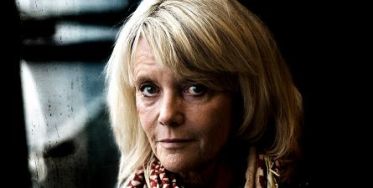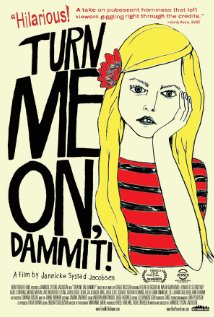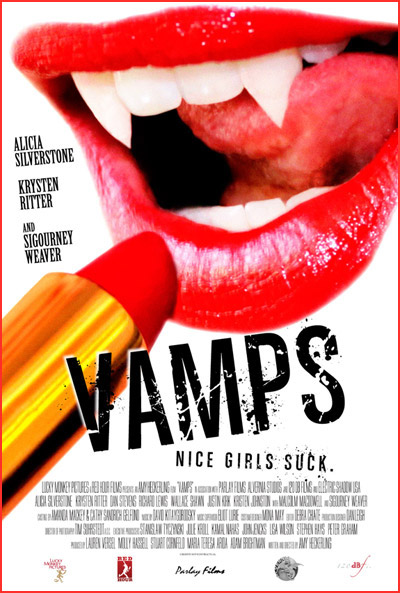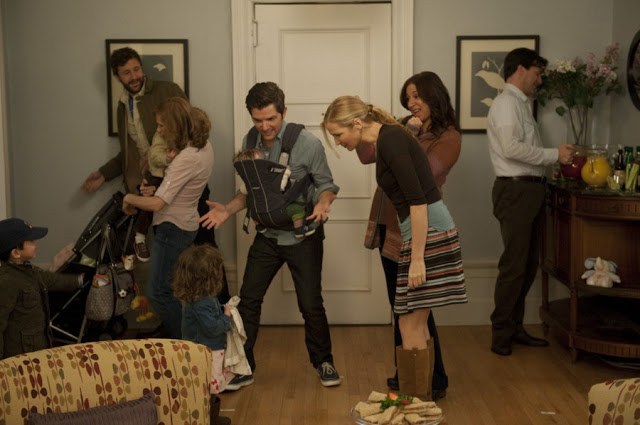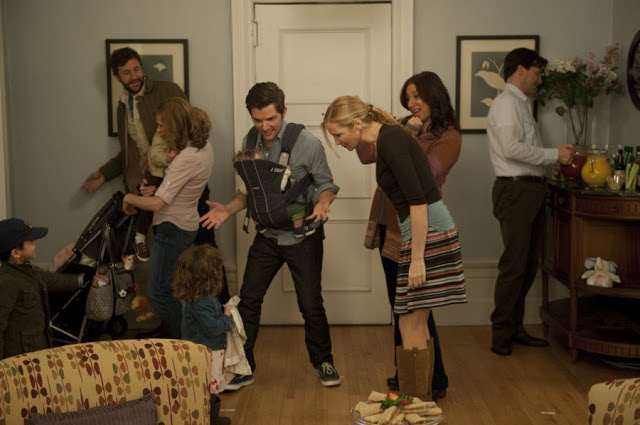 |
| Jessica Chastain as Maya in Zero Dark Thirty |
Written by Megan Kearns. | Warning: Spoilers ahead!!
Driven, relentless, bad-ass women in film always hold a special place in my heart. Ripley from Alien and Aliens, Patty Hewes from Damages, Carrie Mathison from Homeland. Maya, the female protagonist of Zero Dark Thirty, is no exception. But can a film be feminist if it depicts horrific violations of human rights?
Played effortlessly by Jessica Chastain, Maya is a smart, tenacious and perceptive CIA analyst who navigates the 10-year hunt for al-Qaeda terrorist leader Osama bin Laden. Intense and focused, she relentlessly pursues her work with one singular goal: finding bin Laden. Unyielding, she refuses to give up. She’s a cinematic version of Carrie Mathison. Interestingly both women have an irrefutable compass when it comes to being right. They boldly trust and follow their uncanny instincts.
Zero Dark Thirtyis riveting, fascinating and jarring. It assaults the senses with evocative images, haunting music, booming explosions and chilling 911 calls on 9/11. Powerful and exquisitely crafted by Kathryn Bigelow, it is unrelenting in its vision.
As Candice Frederick asserts, Maya anchors and propels the film. With a woman at the center of this story, it’s hard not to question gender. Zero Dark Thirty doesn’t overtly discuss gender politics, as Bigelow points out. Yet it reveals gender dynamics in subtle and important ways.
In the beginning of the film, Maya appears queasy about torture. Yet she refuses to turn away. When Dan (Jason Clarke), another CIA analyst, says she can watch the interrogation on video, she insists on being in the room. Early on, a colleague calls her a “killer,” a moniker that doesn’t quite seem to fit her composed demeanor and soft-spoken voice. Or is that supposed to challenge our stereotypical gender assumptions? But it certainly fits as the film progresses.
 |
| Maya (Jessica Chastain) in Zero Dark Thirty |
We witness a hyper-masculine environment in which Maya’s boss George (Mark Strong) slams his fist on the desk screaming at CIA analysts, “I want targets. Do your fucking jobs. Bring me people to kill.” After years in the field, after her friends have died, after relentlessly pursuing bin Laden, Maya swears, screams at a superior and boldly tells the CIA Director (James Gandolfini) in a room full of men, “
I’m the motherfucker that found this place, sir.” Inoo Kang asserts this one statement draws attention to her gender: “
anyone can be a motherfucker, man or woman – just like anyone can find bin Laden.” Does she adopt stereotypical masculine behavior to adapt? Or is her aggression merely a manifestation of her frustration and obsession? Or is she merely a bundle of contradictions, like most people?
Writer Katey Rich said she was fascinated how Maya’s “
femininity is never talked about out loud, but influences everything she does and the way her colleagues react to her.” All of the male colleagues and superiors refer to her as the infantilizing term “girl” rather than “woman.” Yet Maya engenders enormous respect from her colleagues and superiors. Two times in the film, a superior asks one of Maya’s colleagues if she’s up for the job. In each instance, she’s described as “a killer” and “intelligent,” although James Gandolfini as the CIA Director dismisses that assertion by saying, “We’re all intelligent.” A Navy SEAL trusts Maya’s judgment on bin Laden’s location because of her unwavering confidence.
One of the best things about having a female director? Not only do we see an intelligent and complex female protagonist. We also see female friendship. Passing the Bechdel Test, we see Maya and her colleague and friend Jessica (Jennifer Ehle) debate, strategize, unwind and challenge each other. Reinforcing their friendship with a visual cue, Maya’s screensaver on her computer is a picture of her and Jessica.
 |
| Jennifer Ehle as Jessica in Zero Dark Thirty |
After Maya becomes convinced that a vital lead is dead, it’s young analyst Debbie (Jessica Collins) who makes a crucial discovery through researching old files. She tells Maya that she’s been her inspiration. It was nice to see female admiration and camaraderie, even if Maya is too busy, too focused on work to acknowledge her compliment.
When Jessica asks Maya if she has a boyfriend or is sleeping with a co-worker, Maya firmly tells her no. Jessica encourages her to get a little somethin’ somethin’ to take the edge off. She says, “I’m not that girl that fucks – it’s unbecoming.” Now I’m not exactly thrilled with that statement. But I’m delighted Maya isn’t defined by her relationship to a man. She defines herself.
I’m honestly not entirely sure if Zero Dark Thirty is a feminist film. But with its subtle gender commentary, female friendship, and female protagonist who’s defined by her actions rather than her appearance or her relationships, it’s hard for me to say it’s not.
Only 4 women have ever been nominated for a Best Director Oscar: Lina Wertmüller (Seven Beauties), Jane Campion (The Piano), Sofia Coppola (Lost in Translation) and Kathryn Bigelow (The Hurt Locker). Out of these 4, only the Piano was female-centric. Bigelow is the only woman to ever win. Ever.
Did the Academy ignore Kathryn Bigelow because of sexism? Did they not want to honor a female director twice? Or was it because of the raging shitstorm of controversy regarding the film’s depiction of torture? Or was it because of the pending Senate investigation? And would the Senate have even investigated
Zero Dark Thirty had it been directed by a man? I have a sneaking suspicion that sexism resides at the root of each of these questions.
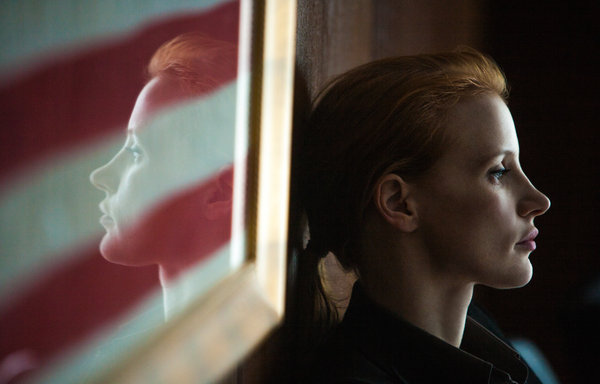 |
| Maya (Jessica Chastain) in Zero Dark Thirty |
Now does depicting horrific atrocities equate approval? Absolutely not. Films like The Accused and The Girl With the Dragon Tattoo portray rape graphically yet exist to combat victim-blaming rape culture. What matters is in the film’s portrayal.
Zero Dark Thirtydoes not shy away from graphic depictions of torture. Bigelow said that while she wished torture “
was not part of that history,” it was. Within the first 20 minutes, we witness detainee Ammar (Reda Kateb) waterboarded, beaten, humiliated, starved, sleep deprived, stress positions by being forced into a tiny box, disoriented with lights and heavy metal music, and walked around with a collar and a chain like a dog. Later, we see other detainees in jumpsuits with wounds and scars. The abuse is horrifying and disturbing to watch. It’s repulsive to see the culmination of the racist, xenophobic colonialism that spurred the use of torture against Muslim Arabs.
Torture does not yield accurate information. Yet Dan repeatedly says to Ammar, “You lie, I hurt you.” When Ammar begs Maya for help, she tells him, “You can help yourself by telling the truth.” Not only does it subvert our gendered assumptions that she would be sympathetic to him. It puts the onus on the tortured detainees, not on the racist atrocities committed by government officials.
 |
| Admiral Bill McCraven (Christopher Stanley) and Maya (Jessica Chastain) in Zero Dark Thirty |
But Zero Dark Thirtyalso shows the inefficacy of torture. When Ammar is put into the box, he lies that he doesn’t know if there will be another attack. And yet we quickly see an attack in Saudi Arabia. We see CIA analysts uncovering intelligence without torture. After Ammar has been abused, demoralized and dehumanized repeatedly for months (years?), Maya and Dan eventually treat him with a modicum of decency and respect. Only then does he finally provide accurate and vital information.
Most tellingly, Dan says he’s leaving as he no longer can torture people. He says he wants to go to DC and do something “normal.” He warns Maya not to be “the last one holding a dog collar when the oversight committee comes.” This sense of awareness doesn’t acquit Dan’s or Maya’s actions. But it does convey that Dan knows that torture is fundamentally wrong.
But Zero Dark Thirtyalso portrays characters who repeatedly say that they can’t do their job without torture — or as they put it “enhanced interrogation techniques” — even after finding leads without torture and even after torture fails to stop terrorist attacks, which undercuts the message that torture is ineffective and reprehensible. It frames torture more as a Machiavellian means to an end: it’s not pleasant but still kinda necessary. But maybe that’s the point — to showcase the traditional thinking of the CIA in how to obtain intelligence, even when everything points in the opposite direction. While it certainly doesn’t condone torture, sadly Zero Dark Thirty doesn’t outright condemn human rights atrocities either.
However, the biggest clue as to the film’s overall stance appears in its finale.
Zero Dark Thirtymay not criticize torture as much as it could or should. But that doesn’t mean it panders to politics. Rather it questions the course the U.S. has taken. It makes a bold and damning statement
critiquing post-9/11 failures and
the emptiness of the War on Terror. When bin Laden’s compound is invaded and he’s killed, it’s a taut and suspenseful albeit disturbing sequence. In the end, there’s no rejoicing, no celebration.
The last image we see is Maya, alone shedding silent tears. She allows herself a much-needed emotional release. While she should be satisfied at the culmination of her life’s work, pain tinges this moment. Lost and forlorn, she doesn’t know where to go next.
Zero Dark Thirtydoesn’t provide any easy answers. Rather it asks complex questions. Like any masterful work of art, it challenges us and pushes us, at times in uncomfortable ways. It forces us to look at ourselves as a nation, to our collective pain and to our response to tragedy. Zero Dark Thirty essentially asks us if it was all worth it. It asks how we can move forward. Just like Maya, where do we go from here?







